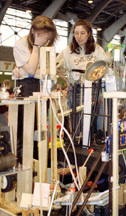 Purdue News
Purdue News
 Purdue News
Purdue News
NOTE TO JOURNALISTS: Video and photographs of past contests are available or download here. An ISDN line is available for radio interviews. Journalists will not be allowed on the stage with the machines during the competition, but they are welcome on stage before and after the contest. Purdue will provide video and photo pool coverage and direct audio and video feeds. Video b-roll, photos and a news release will be available the afternoon of the event. Satellite assistance is available. For more information, contact Amanda Siegfried, News Service, (765) 494-4709; e-mail, amanda_siegfried@purdue.edu
January 17, 1997

|
The contest, free and open to the public, begins at 11:30 a.m. in Purdue's Elliott Hall of Music. The winner of the Purdue contest goes on to represent the university at the National Rube Goldberg Machine Contest, to be held at Purdue on April 5.
Students build their machines by combining the principles of physics and engineering with common objects, such as marbles, mouse traps, vacuum cleaner and VCR parts, stuffed animals, bowling pins, electric drills, tin cans, rubber tubing, and small kitchen appliances.
"It's amazing what turns up in these machines," said Daniel Colpi, student chairman of the contest and a junior in computer engineering from Southport, Conn. "Although the task concerns electronic devices, the judges will be looking for innovative use of nonpowered steps, which harkens back to the Rube Goldberg tradition."
Goldberg was a cartoonist who specialized in drawing whimsical machines with complex mechanisms to perform simple tasks.
Machines also will be judged and awarded points based on the creative use of materials and use of related themes. Each machine must run, be reset and run again in nine minutes. Points are taken off for human intervention after the machine starts or for exceeding the time limit.
Teams expecting to compete in the February contest include the Society of Hispanic Professional Engineers, the Society of Manufacturing Engineers, a joint team of the Society of Women Engineers and Society of Physics Students, Purdue residence halls, and contest sponsor Theta Tau, a professional engineering fraternity.
The contest is organized by student members of the Purdue chapter of Theta Tau, with support from industrial sponsor General Electric. The fraternity also maintain a World Wide Web page at https://cernan.ecn.purdue.edu/~colpi//RUBE/Index.html
The winning team receives $300 and a trophy, second place gets $200, and third place receives $100. GE also will give prizes to the top three finishers. In addition, a "People's Choice" award will be given to the team whose machine gets the most votes from audience members.
The contest at Purdue started in 1949 and ran until 1955. It was revived by Theta Tau in 1983 to celebrate National Engineers' Week. The first National Rube Goldberg Machine Contest was held at Purdue in 1988.
The contests have attracted nationwide attention, with coverage in publications from the Wall Street Journal and Discover to People and Seventeen magazines. They also have been featured on a number of television shows, including "Newton's Apple," "Late Night With David Letterman," "Live With Regis and Kathie Lee," "The Tonight Show Starring Johnny Carson," NBC's "Today," ABC's "Good Morning America," CBS's "This Morning," CBS News, and CNN.
The contest also has received international television coverage from Australian-produced "Beyond 2000" and a Japanese science and technology program called "High-Tech Shower."
Source: Daniel Colpi, (765) 743-2461; e-mail, colpi@cernan.ecn.purdue.edu
Writer: Amanda Siegfried, (765) 494-4709; e-mail, amanda_siegfried@purdue.edu
Purdue News Service: (765) 494-2096; e-mail, purduenews@purdue.edu
Photo Caption
At the Rube Goldberg Machine Contest, the machines don't always work as planned, as
these Purdue students learned the hard way during the 1996 contest. The challenge
for the 1997 contest is to build a machine that uses at least 20 steps to load a
CD into a computer and run a program, or into a CD player and play music. (Purdue News Service
Photo by David Umberger)
Color photo, electronic transmission, and Web and ftp download available. Photo ID:
Special Collections/1997 Rube.one
Download here